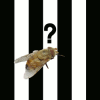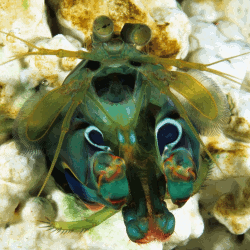-
Viewpoint on 'IONS'
Viewpoint on 'Scientific Literacy'
- Proudly sponsored by
-


-
Blue Light Beats the Blues

We all appreciate how a walk in the sun can do wonders for lifting our spirits, even though we may not know the exact scientific reasons behind the fact that sunshine helps fight the blues.
-
EPS QEOD Thesis Prizes: The Winners of 2011

Six young scientists have received the prestigious QEOD Thesis Prize, awarded by the Quantum Electronics and Optics division (QEOD) of the European Physical Society (EPS). Congratulations!
-
Baffle the Bug!

Puzzled by the zebra’s appearance? Experimental data of recent research supports the idea that zebras developed their striped coat to stave off horseflies.
Volume 1 Story 3 - 25/6/2008

It is fascinating to realize how creative nature is.
We invented photonic crystals, but they had been on butterfly wings for hundreds of millions of years.
We came up with the idea of lasers, but giant lasers had been operating for billions of years in nebulae lost in deep interstellar space.
However, until a few months ago we could still be proud to say that we had outpaced nature in mastering polarization vision.
Now Sonja Kleinlogel from Max Planck Institute for Biophysics in Frankfurt (Germany), Tsyr-Huei Chiou from the University of Maryland in Baltimore (USA), and coworkers have proved us wrong.
Nature was there first — again!
A stomatopod species, a crustacean similar to a shrimp, can distinguish circularly polarized light, and
the mantis shrimp even has perfect polarization vision.
They can see a world invisible to all other animals, and disclosed to us only by the technological advances of the last decades.
"It has been known since long ago that various animals can distinguish linear polarization. For example, they exploit it in navigating. Ants and bees take advantage of the slight linear polarization of the sky light to orient themselves," says Kleinlogel. "However, it was generally believed that animals were insensitive to circular polarization."
Polarization is a characteristic of waves, and light behaves as a wave. We can generate a linearly polarized wave by holding the end of a long stretched rope and waving it. A vertically polarized wave results from shaking it up and down in the vertical plane, and a horizontally polarized one from shaking it left and right in the horizontal plane. If we now move the end of the rope in a circle, a circularly polarized wave will result. Of course, it can be either left or right circularly polarized, depending on the sense of the rotation.
How is it possible to see linear polarization? "Microvilli," explains Kleinlogel, "the part of the visual cells sensitive to light, naturally respond to linear polarization." Indeed, they are an array of tubelike membranes, which respond to only one linear polarization depending on how they are oriented. Somehow, light that is linearly polarized along a certain direction can only excite a microvillus with the same orientation. Ants, bees, and other animals have clusters of cells with such membranes all aligned in the same way to distinguish various polarizations; other animals, such as humans, have these membranes randomly oriented and, therefore, they are not sensitive to light polarization. However, when it comes to circularly polarized light, microvilli are always responsive regardless of their orientation, since it is oscillating in all directions.
"The idea of circular polarization vision in stomatopod crustacean was first published in 1991 by Justin Marshall and coworkers [1]," Chiou notes, "based on the architecture of the photoreceptors in stomatopods." However, it is only in a recent article that Chiou, Kleinlogel, and colleagues demonstrated that such structure behaves as a quarter wave plate, an optical element that transforms left and right circularly polarized light into perpendicularly oriented — for example, vertical and horizontal — linearly polarized light. After such transformation the microvilli can do their job — distinguishing the two linear polarizations — and the animal gains information about the original light polarization state. Furthermore, they verified that these animals really use circularly polarized light by training them to associate either left or right circularly polarized light with a food reward. And indeed the crustaceans were responsive.
The mantis shrimp studied by Kleinlogel and White goes a degree further: it combines circular and linear polarization measurements to fully reconstruct the light polarization state. Andrew White from the University of Queensland (Australia) explains, "each eye of the mantis shrimp measures the polarisation components that are precisely required for optimal polarisation vision."
So for what is perfect polarization vision useful? Humans use polarized filters and imaging in everyday photography, medical photography, and object-detection in turbid environments. "Under water you have two problems: colors disappear, light is scattered." Kleinlogel points out, "additionally the reefs and waters that many stomatopods inhabit are often turbid. With polarizing filters things look better, as fishermen well know. Furthermore, various animals reflect polarized light." "Currently we have found more than a dozen of stomatopod species with polarized light-reflecting body parts," explains Chiou, "by arranging a birefringent material above the polarized light reflector, some animals are able to generate circularly polarized light signals." "Some of the animals they like to eat are transparent," White notes, "and quite hard to see in sea-water — except they're packed full of polarizing sugars — I suspect they light up like Christmas trees as far as these shrimps are concerned." "And of course," Kleinlogel concludes, "they can still flirt with each other using fancy polarization cues!"
[1] N. J. Marshall et al., The compound eyes of mantis shrimps (Crustacea, Hoplocarida, Stomatopoda). I. Compound eye structure: The detection of polarised light., Philos Trans R Soc Lond B Biol Sci 334, 33-56 (1991).

Super-Vision for Mr. Shrimp
There is an invisible world illuminated by polarized light. A world that has been disclosed to us only by the technological advances of the last decades. Surprisingly, various Australian shrimps can see it.
Mantis shrimp (Gonodactylus smithii). Each of its eyes measures the six polarisation components that are precisely required. Photograph: Roy Caldwell.
"It has been known since long ago that various animals can distinguish linear polarization. For example, they exploit it in navigating. Ants and bees take advantage of the slight linear polarization of the sky light to orient themselves," says Kleinlogel. "However, it was generally believed that animals were insensitive to circular polarization."
Polarization is a characteristic of waves, and light behaves as a wave. We can generate a linearly polarized wave by holding the end of a long stretched rope and waving it. A vertically polarized wave results from shaking it up and down in the vertical plane, and a horizontally polarized one from shaking it left and right in the horizontal plane. If we now move the end of the rope in a circle, a circularly polarized wave will result. Of course, it can be either left or right circularly polarized, depending on the sense of the rotation.
How is it possible to see linear polarization? "Microvilli," explains Kleinlogel, "the part of the visual cells sensitive to light, naturally respond to linear polarization." Indeed, they are an array of tubelike membranes, which respond to only one linear polarization depending on how they are oriented. Somehow, light that is linearly polarized along a certain direction can only excite a microvillus with the same orientation. Ants, bees, and other animals have clusters of cells with such membranes all aligned in the same way to distinguish various polarizations; other animals, such as humans, have these membranes randomly oriented and, therefore, they are not sensitive to light polarization. However, when it comes to circularly polarized light, microvilli are always responsive regardless of their orientation, since it is oscillating in all directions.
"The idea of circular polarization vision in stomatopod crustacean was first published in 1991 by Justin Marshall and coworkers [1]," Chiou notes, "based on the architecture of the photoreceptors in stomatopods." However, it is only in a recent article that Chiou, Kleinlogel, and colleagues demonstrated that such structure behaves as a quarter wave plate, an optical element that transforms left and right circularly polarized light into perpendicularly oriented — for example, vertical and horizontal — linearly polarized light. After such transformation the microvilli can do their job — distinguishing the two linear polarizations — and the animal gains information about the original light polarization state. Furthermore, they verified that these animals really use circularly polarized light by training them to associate either left or right circularly polarized light with a food reward. And indeed the crustaceans were responsive.
The mantis shrimp studied by Kleinlogel and White goes a degree further: it combines circular and linear polarization measurements to fully reconstruct the light polarization state. Andrew White from the University of Queensland (Australia) explains, "each eye of the mantis shrimp measures the polarisation components that are precisely required for optimal polarisation vision."
So for what is perfect polarization vision useful? Humans use polarized filters and imaging in everyday photography, medical photography, and object-detection in turbid environments. "Under water you have two problems: colors disappear, light is scattered." Kleinlogel points out, "additionally the reefs and waters that many stomatopods inhabit are often turbid. With polarizing filters things look better, as fishermen well know. Furthermore, various animals reflect polarized light." "Currently we have found more than a dozen of stomatopod species with polarized light-reflecting body parts," explains Chiou, "by arranging a birefringent material above the polarized light reflector, some animals are able to generate circularly polarized light signals." "Some of the animals they like to eat are transparent," White notes, "and quite hard to see in sea-water — except they're packed full of polarizing sugars — I suspect they light up like Christmas trees as far as these shrimps are concerned." "And of course," Kleinlogel concludes, "they can still flirt with each other using fancy polarization cues!"
[1] N. J. Marshall et al., The compound eyes of mantis shrimps (Crustacea, Hoplocarida, Stomatopoda). I. Compound eye structure: The detection of polarised light., Philos Trans R Soc Lond B Biol Sci 334, 33-56 (1991).
Giovanni Volpe
2008 © Optics & Photonics Focus
GV is currently working on his doctoral thesis at The Institute of Photonic Sciences (ICFO), Barcelona (Spain).

T.-H. Chiou, S. Kleinlogel, et al., Circular Polarization Vision in a Stomatopod Crustacean, Curr Biol (2008) 18, 429-434 (link).
S. Kleinlogel and A. G. White, The Secret World of Shrimps: Polarisation Vision at Its Best, PLoS ONE (2008) 3, e2190 (link).